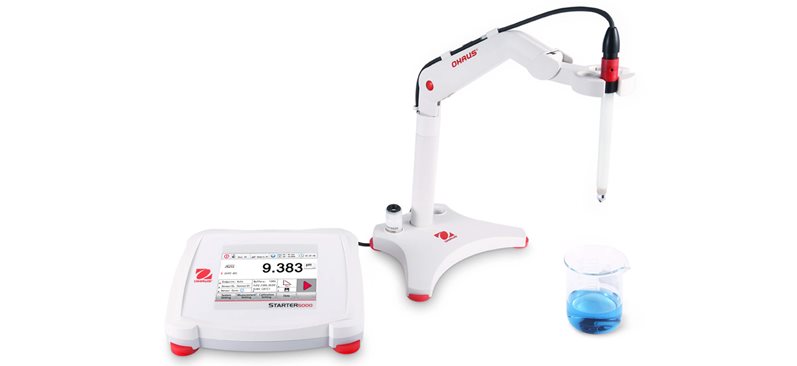
To make sure your pH electrodes always give you reliable results, you need to calibrate them daily, weekly or prior to using them. By performing the calibration, you can ensure that the electrodes are in good working condition. Below is a quick and easy procedure for electrode diagnostics.
- Required Solutions
- pH 7.00 Buffer
- pH 4.01 Buffer
- pH Electrode Filling Solution
- Deionized water (as DI water)
Refer to the flowchart to find the matching electrode symptom, the corresponding change from the initial resistance value, the possible causes, and suggested corrective actions. For detailed recommended corrective action procedures (as referenced in Table 2 and the Figure 1 of the flowchart) see below:
 Figure 1 pH Electrode Troubleshooting Flow Char
Figure 1 pH Electrode Troubleshooting Flow Chart
Table 1 electrode symptom
| Symptom |
Possible Causes |
Next step (Corrective action) |
①
Won't auto calibrate (cannot run auto calibration with pH 4.01, 7.00, and 10.01 buffers) |
Short circuit (glass bulb cracked/or stem/or outer body; damaged cable or BNC connector, moisture intrusion) |
Replace the electrode |
| Bad buffer solution |
Use fresh, unexpired buffers |
| Wrong buffer set in setup |
Choose the correct buffer set. Meter is auto-recognizing USA or China GB/EURO pH buffers set (see Tables 1), depending on the selected set in setup. |
Damaged (scratched) glass bulb by soil or sand samples; aged glass bulb
Chemically damaged bulb, e.g., due to exposure of the electrode to ammonium bifluoride or hydrofluoric acid for long period of time (hours) |
Check electrode performance |
| Dehydrated/dried glass bulb (after ethanol samples, organic solvents, etc. or dry storage) |
Rehydrate pH bulb |
| Dirty bulb, clogged junction |
Clean the electrode |
| Dried gel (only non-refillable gel electrodes) |
Replace the electrode |
| Dirty or contaminated glass bulb; Severely clogged or sealed junction |
Clean electrode and check performance |
②
pH and mV readings in pH 4.01 and pH 7.00 buffers are the same |
Short circuit (glass bulb cracked/or stem/or outer body; damaged cable or BNC connector, moisture intrusion) |
Replace the electrode |
③
Slope is bad (out of 92 -102% range or mV difference between readings in pH 4 and pH 7 is not within 160-180 mV) |
Short circuit (glass bulb cracked/or stem/or outer body; damaged cable or BNC connector, moisture intrusion);
Dried gel (only non-refillable gel
electrodes) |
Replace the electrode (see procedure # 1) |
| Damaged or aged bulb |
Check electrode performance |
| Dirty bulb |
Clean the electrode |
| Buffers not fresh or out of expired |
Use fresh, not expired buffers |
| Severely clogged or sealed junction |
Clean electrode and check performance |
| Dehydrated/dried glass bulb (after ethanol samples, organic solvents, etc. or dry storage) |
Rehydrate pH bulb |
④
Slow response, drift (for example, reading changes with time, cal check is not within criteria) |
Aged electrode |
Check electrode performance |
| Dry bulb |
Rehydrate pH bulb |
Dried gel (only non-refillable gel
electrodes) |
Replace the electrode |
| Severely clogged or sealed junction |
Clean the electrode |
| Clogged junction |
Clean electrode and check performance |
How to Check Electrode Performance
1. Change the measurement mode to read mV.
2. Although it is not always required, it is best to begin calibration with pH 7 buffer.
3. Rinse the pH electrode with DI water and then with pH 7 buffer solution - place the electrode into pH 7 buffer at room temperature (20 - 25ºC).
4. Wait for the reading to stabilize and record the mV value.
5. Rinse electrode with DI water.
6. Repeat the same steps to record mV reading in the pH 4.01 buffer.
7. Refer to follow Table 2 to verify that mV reading is ± 30 mV from the theoretical mV reading of the buffer.
8. If mV readings are out of range, replace the electrode. If mV readings are correct, perform the corrective action to clean the electrode.
Table 2 the theoretical mV reading of the buffer
| US standard |
China, GB, EU standard |
| Buffer pH |
mV range |
Buffer pH |
mV range |
| 1.68 |
+285 ~ +345 |
1.68 |
+285 ~ +345 |
| 4.01 |
+207 ~ +147 |
4.01 |
+207 ~ +147 |
| 7.00 |
-30 ~ +30 |
6.86 |
+38 ~ -22 |
| 10.01 |
-207 ~ -147 |
9.18 |
-99 ~ -159 |
| 12.46 |
-293 ~ -353 |
|
|
How to Clean the Electrode?
Clean the electrode with the appropriate cleaning solution. Soak overnight in pH 4 buffer, rinse with DI water and recalibrate in fresh buffers. If all these steps failed, replace the electrode.
How to Rehydrate the pH Bulb?
Rehydrate the sensing bulb in pH 4 buffer (overnight soak is recommended). Store the electrode in appropriate pH storage solution (3M KCl solution).